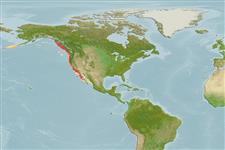Myxines (hagfishes) >
Myxiniformes (Hagfishes) >
Myxinidae (Hagfishes) > Eptatretinae
Etymology: Eptatretus: hepta (Gr.), seven; tretos (Gr.), perforated (i.e., with holes), referring to seven gill apertures on what would later be described as Homea banksii (=E. cirrhatus) [range within genus is 6-14 pairs of gill apertures] (See ETYFish); stoutii: In honor of Arthur B. Stout (1814-1898), surgeon and corresponding secretary of the California Academy of Sciences [see box, below] (See ETYFish).
Eponymy: Dr Arthur Breese Stout (1814–1898) was a prominent surgeon in San Francisco. [...] (Ref. 128868), visit book page.
Environment: milieu / climate zone / depth range / distribution range
Écologie
marin démersal; non migrateur; profondeur 16 - 966 m (Ref. 96339). Temperate; 58°N - 20°N, 137°W - 105°W
Eastern Pacific: southeastern Alaska to Bahia San Pablo, central Baja California, Mexico.
Length at first maturity / Taille / Poids / Âge
Maturity: Lm 42.0 range ? - ? cm
Max length : 63.5 cm TL mâle / non sexé; (Ref. 96339)
Épines dorsales (Total) : 0; Rayons mous dorsaux (Total) : 0; Épines anales: 0; Rayons mous anaux: 0. No true fins - one dorsal finfold, far back, median, very low, continuous with caudal; caudal broad, rounded; ventral finfold very low, origin somewhat posterior to last gill pore, extending to anus (Ref. 6885). Dark brown, tan, gray, or brownish red, often tinted with blue or purple, never black, lighter ventrally, rarely with large patches of white; preserved specimens light brown (Ref. 6885).
Inhabits fine silt and clay bottoms (Ref. 6885). Enters large fishes by way of the mouth and anus and feed on its viscera and muscles (Ref. 6885). May greatly diminish catches taken with fixed gears (Ref. 6885). Produces mucilaginous slime when harassed (Ref. 6885). Probably exhibits hermaphroditism (Ref. 56947). Due to its primitive metabolism it is collected for research purposes (Ref. 6885). TBK: demerspelag.
Copulatory organ absent (Ref. 51361). Presence of bisexual juvenile gonad, requires further investigation regarding hermaphroditism (Ref. 56947). In one study (Ref. 40710), hermaphroditism is exhibited by only 0.2% of the individuals studied.
Fernholm, B., 1998. Hagfish systematics. p. 33-44. In J.M. Jørgensen, J.P. Lomholt, R.E. Weber and H. Malte (eds.) The biology of hagfishes. Chapman & Hall, London. 578 p. (Ref. 31276)
Statut dans la liste rouge de l'IUCN (Ref. 130435: Version 2024-1)
Menace pour l'homme
Harmless
Utilisations par l'homme
Pêcheries: sans intérêt; Aquarium: Aquariums publics
Outils
Articles particuliers
Télécharger en XML
Sources Internet
Estimates based on models
Preferred temperature (Ref.
123201): 5.8 - 9.4, mean 7.1 °C (based on 54 cells).
Phylogenetic diversity index (Ref.
82804): PD
50 = 0.5000 [Uniqueness, from 0.5 = low to 2.0 = high].
Bayesian length-weight: a=0.00288 (0.00169 - 0.00493), b=2.88 (2.73 - 3.03), in cm total length, based on LWR estimates for this species & (Sub)family-body (Ref.
93245).
Niveau trophique (Ref.
69278): 4.2 ±0.70 se; based on food items.
Résilience (Ref.
120179): Faible, temps minimum de doublement de population : 4,5 à 14 années (Fec = 28).
Fishing Vulnerability (Ref.
59153): Moderate to high vulnerability (45 of 100).
